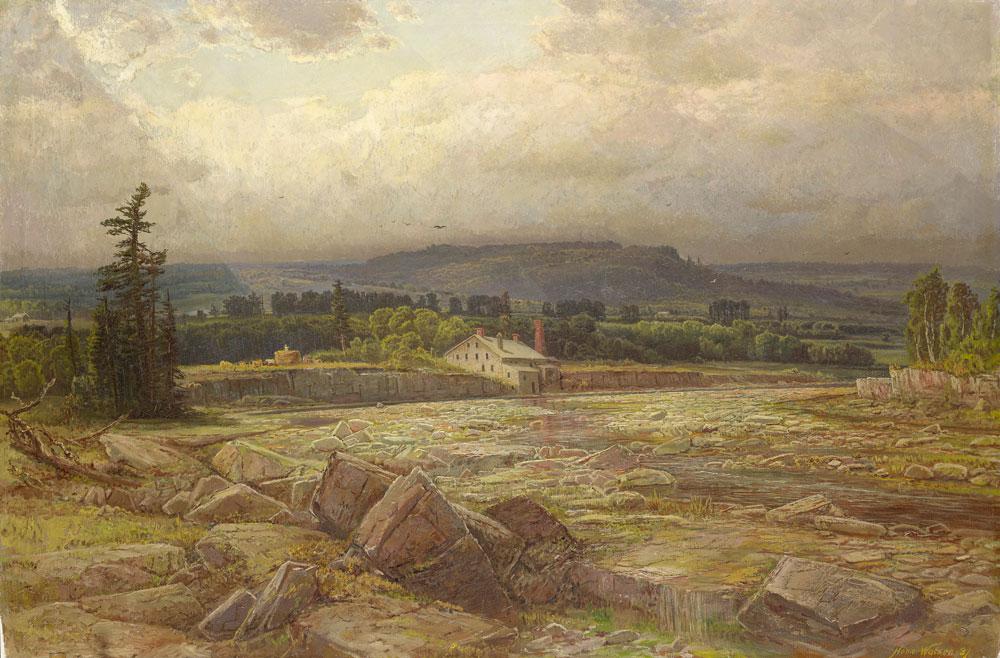If it’s true—and it seems to be—that Oscar Wilde, on viewing a painting by Canada’s homespun, self-taught and yet, at that point, internationally acclaimed landscape painter Homer Watson (1855–1936), pronounced him to be “the Canadian Constable,” adding that he simply “must know that man,” then I suppose we may have to modify the strangely condescending attitude it is so easy to feel now for the oeuvre of this modest, hardworking painter from the village of Doon (now part of the city of Kitchener).
Of course, Wilde may have been having an off day, critically speaking (his views on the visual arts were less compelling than his ideas about everything else). But it is nevertheless impressive that when a painting of Watson’s called The Pioneer Mill, from 1880, was shown at the first Royal Canadian Academy of Arts exhibition in Ottawa that same year, it was purchased by the Governor General of Canada, the Marquis of Lorne, as a gift for Queen Victoria. The Governor General paid Watson $300 for the picture—a whack of money in 1880.
Two years later, in 1882, the royal collection was augmented by the arrival of another Watson: The Last Day of the Drought. Homer was riding high.
Now, both The Pioneer Mill and The Last Day of the Drought centrally inform a roseate exhibition at the Homer Watson House & Gallery titled “Bringing Heritage Home,” heritage being, I assume, the presence of these two noble Watsons—which, hitherto hung in the Queen’s private residence, are making their first reappearance in Kitchener since their voyage abroad more than a century ago.
The first time I visited the Homer Watson House & Gallery—it was many years ago—it was to try to learn something about the artist who had painted The Death of Elaine in 1877 (owned by the Art Gallery of Ontario)—a fulsomely romantic work based on the “Lancelot and Elaine” section of Tennyson’s Idylls of the King (“…for she did not seem as dead / But fast asleep, and lay as tho’ she smiled….”). The painting shows the body of Elaine being rowed by some Charon-like figure to its final resting place. I liked it, as goopy as it was, because it reminded me of Böcklin’s The Isle of the Dead (which is one of my favourite paintings) from 1880—although the Watson painting predates the Böcklin by three years.
The Homer Watson House & Gallery is a charming place, a modern gallery built around Watson’s original home and studio. I remember being impressed—as I still am—by the decorative frieze the artist painted in 1894 all along the upper reaches of the studio walls, an unfurling ribbon of homage to the painters he admired at the time (and whose styles he attempted here to recreate): among these were Corot, Constable and Turner.
But what of the Queen’s two pictures? Do they function as the linchpin holding this affectionate exhibition together?
Well, yes and no. Both The Pioneer Mill and The Last Day of the Drought are exceedingly (and probably deliberately) old-fashioned, their conventionalized vistas engulfed in that gravy-brownness that seemed, at the time, to bespeak dignity and loftiness of purpose. Despite historian J. Russell Harper’s having identified Watson as “the man who first saw Canada as Canada, rather than as dreamy blurred pastiches of European painting,” these two royal Watsons are as dreamy as you can imagine, if not blurred, each showing more affiliation to certain 17th-century Dutch landscapes (with an added whiff of Gainsborough) than to the painting that was more of Watson’s era—that of the Barbizon School (Millet, Daubigny, Corot et al.) as well as that of the French Impressionists. It is a long journey in understanding, if not in time, from Homer Watson to Camille Pissarro or Claude Monet.
But to be fair to Watson and to the exhibition, these two paintings, while illustrious, were very early in the painter’s career—indeed, The Pioneer Mill was his first major work. You can see, both over the course of “Bringing Heritage Home” and in related online Watson exhibitions, how the artist developed over the next decades.
He didn’t travel far, aesthetically speaking, but he did make progress. His Landscape with Horse and Rider from 1889 looks like a Salvator Rosa, but his Evening Scene from 1894, with its brawling, tumultuous river and rapids, shows glimmers of the moonlight oddness of an Albert P. Ryder. His Pioneers at Lunch (c. 1900) feels like a forceless Théodore Rousseau. But by 1925, in a work like Untitled (Large Tree by Stream), he is venturing into pink-purple skies and building them with fatter brushstrokes. Although he lived to age 81, what Homer Watson really needed was more time—time which was, of course, denied him.









